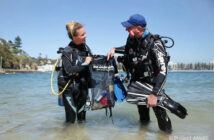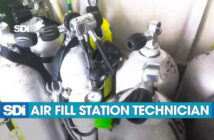Mike Adam of Rothesay, New Brunswick, set out in low visibility to inspect a boat mooring. Mike’s buddy was in a kayak above him keeping a lookout. See what it’s like to scuba dive in the Kennebecasis River, New Brunswick, during the spring freshet.
The word freshet is most widely used to describe a spring thaw in rivers in upper North America caused by snow and ice melt. When the snowpack in the river’s watershed melts, a spring freshet will last several weeks on major river systems, resulting in substantial flooding of flood plains. Depending on the depth of the snowpack and the local average rate of warming temperatures, freshets can occur with varying intensity and length. Flooding can be worsened by deeper snowpacks that melt rapidly. Late spring melts allow for faster flooding due to the longer days and higher solar angle, which allows for faster average melting temperatures to be reached.
Since they have significantly more staying strength, do less harm to the marine environment, and are more comfortable, boat moorings are often used instead of temporary anchors.
Dive Report: Mike Adam
I was diving on a boat mooring in Rothesay, New Brunswick to inspect the condition of the chain, cement block and all the shackles/connections. This had to be done to make sure a boat could safely be moored later this month. I wanted to make a video describing how I check a mooring and also to show what it is like to dive in the Kennebecasis river during the spring freshet. It was interesting to dive in the water with such low visibility due to the water being so full of sediment and debris. It was as dark as night and would have been impossible to check without a flashlight. I was hoping to see a few fish on this dive as I have seen sturgeon at this location in the past but due to the visibility, it was impossible to see more than 6 feet at times. The max depth of the dive was 25 feet and the water temperature was 45°F. It took me less than 20 min to check the mooring and I only used 1000 PSI. I could have done the check faster but I was also trying to film a video. My friend was in a kayak and keeping tabs on me.
Mike Adam
Read the Scuba News Canada Article Hand Picking Bay of Fundy Scallops: Catch, Cook and Eat
Mike’s mission is to encourage more diving in the Maritime province of New Brunswick. He also makes historical videos in addition to diving videos. This year, he’ll be documenting aviation crashes in the province of New Brunswick. In this province alone, there are over 300 recorded accidents, and he has teamed up with the Canadian Aviation Historical Society to record the history and stories of the pilots who perished in some of these crashes. Mike has also partnered with the “Hammond River Angling Association” to create a series of videos for them about salmon and the protection of one of our local rivers, the Hammond River.
Mike’s summer 2021 adventures will be accompanied by The Scuba News Canada, which will cover his work in the coming months.








